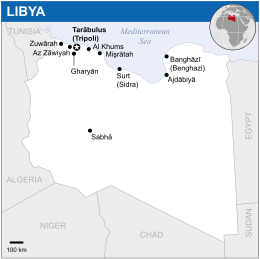Libyan Arab Jamahiriya (1977–2011): Difference between revisions
More languages
More actions
(Brief overview of Libya's economic history was included) Tag: Visual edit |
m (Edited the Libyan infobox) Tag: Visual edit |
||
| Line 10: | Line 10: | ||
| image_map = Libya map.svg | | image_map = Libya map.svg | ||
| map_width = 260 | | map_width = 260 | ||
|legislature=General People's Congress| area_km2 = 1,759,541 | |official_languages=Arabic|religion=Islam|demonym=Libyan|legislature=General People's Congress| area_km2 = 1,759,541 | ||
| population_estimate = 6,355,100 | | population_estimate = 6,355,100 | ||
| population_estimate_year = 2010 | | population_estimate_year = 2010 | ||
|currency=Libyan Dinar|largest_city=capital|mode_of_production=[[Socialism|Socialism]]| government_type = Unitary [[Islam|Islamic]] [[Socialism|Socialist]] [[Jamahiriya]] | |currency=Libyan Dinar|p1=Libyan Arab Republic|s1=State of Libya|largest_city=capital|mode_of_production=[[Socialism|Socialism]]| government_type = Unitary [[Islam|Islamic]] [[Socialism|Socialist]] [[Jamahiriya]] | ||
|leader_title1=Leader of the Revolution|leader_name1=[[Muammar_Gaddafi|Muammar Gaddafi]]|leader_title2=Secretary General of the General People's Congress | |leader_title1=Leader of the Revolution|leader_name1=[[Muammar_Gaddafi|Muammar Gaddafi]]|leader_title2=Secretary General of the General People's Congress | ||
(head of state)|leader_name2=Mohamed Abu al-Qasim al-Zwai}} | (head of state)|leader_name2=Mohamed Abu al-Qasim al-Zwai}} | ||
Revision as of 01:09, 24 March 2023
| Socialist People's Libyan Arab Jamahiriya (1977–1986) الجماهيرية العربية الليبية الشعبية الاشتراكية al-Jamāhīrīyah al-'Arabīyah al-Lībīyah ash-Sha'bīyah al-Ishtirākīyah Great Socialist People's Libyan Arab Jamahiriya (1986–2011) الجماهيرية العربية الليبية الشعبية الإشتراكية العظمى al-Jamāhīrīyah al-'Arabīyah al-Lībīyah ash-Sha'bīyah al-Ishtirākīyah al-'Uẓmá | |||||||||
|---|---|---|---|---|---|---|---|---|---|
| 1977–2011 | |||||||||
 | |||||||||
| Capital and largest city | Tripoli | ||||||||
| Official languages | Arabic | ||||||||
| Religion | Islam | ||||||||
| Demonym(s) | Libyan | ||||||||
| Dominant mode of production | Socialism | ||||||||
| Government | Unitary Islamic Socialist Jamahiriya | ||||||||
• Leader of the Revolution | Muammar Gaddafi | ||||||||
• Secretary General of the General People's Congress
(head of state) | Mohamed Abu al-Qasim al-Zwai | ||||||||
• Secretary General of the General People's Committee
(head of government) | Baghdadi Mahmudi | ||||||||
| Legislature | General People's Congress | ||||||||
| History | |||||||||
• Established | 1977 | ||||||||
• Dissolution | 2011 | ||||||||
| Area | |||||||||
• Total | 1,759,541 km² | ||||||||
| Population | |||||||||
• 2010 estimate | 6,355,100 | ||||||||
| Currency | Libyan Dinar | ||||||||
| |||||||||
The Great Socialist People's Libyan Arab Jamahiriya was a non-Marxist socialist state in North Africa from 1977 to 2011 led by Muammar Qaddafi. In 2010, Libya had the highest human development index of any country in Africa.[1]
History
End of the Cultural Revolution and Declaration of People's Authority
Libyan-Chadian War
2000s
Arab Spring
Economy
Prior to the discovery of oil in 1959, Libya's economy was primarily based on agricultural produce. Due to Libya's lack of fertile lands, agrarian production was severely limited, making Libya one of the poorest countries in the world of that time.[2]
"Libya's great merit as a case study is as a prototype of a poor country. We need not construct abstract models of an economy where the bulk of the people live on a subsistence level, where per capita income is well below US$ 50 per year, where there are no sources of power and no mineral resources, where agriculture expansion is severely limited by climatic conditions, where capital formation is zero or less, where there is no skilled labour supply and no indigenous entrepreneurship... Libya is at the bottom of the range in income and resources and provides a reference point for comparison with all other countries" — Benjamin Howard Higgins
The discovery of oil and the exploitation and development of these resources by Western enterprises would allow the new RCC led government to begin a campaign for rapid development of indigenous manpower and industrial sectors in the aftermath of the nationalization of western oil companies. The General People's Congress would continue prioritize the availability of goods and services to the masses rather than to drive up profits.[2]
Since the execution of the Great September Revolution by the Revolutionary Command Council (RCC), the Libyan economy was gradually transformed from a neo-colonized capitalist framework to socialism. The new government significantly increased the size and role of the public sector as nationalization of foreign enterprises came into fruition. Public ownership over productive forces would reach its peak in the 80s, as most industries would be managed by State Owned Enterprises or People's Congresses. From this point the public sector would come to dominate all sectors of production in Libya.[2]
By the late 90s to early 2000s, the Libyan Arab Jamahiriya would begin to open up its economy after taking responsibility for the Lockerbie Bombing as a means of getting rid of Western sanctions which plagued attempts of development by the Jamahiriya. International sanctions spearheaded by the United States led to a period of economic stagnation and failure to reach over half of the country's productivity aims. The ratification of law 9 of 1992 on partnerships provisions by the General People's Congress marked the beginning of the relaxation on private enterprises. Law 5 of 1997 on encouragement of foreign capital investment was also enacted years later in an attempt to attract foreign capital into the country.[2]
Government
People's Congresses
The first formal principle body of the Jamahiriya political framework, the People's Congresses, are mass organizations on a local scale comprising of all registered adults in a local community. It is the smallest, most basic unit of administration in Libyan society. Congresses are organized on the basis of population density, need for services and availability of resources necessary as a means of ensuring the efficiency of the Jamahiriya system. Due to this, the number and size of People's Congressional boundaries may increase or decrease. The People's Congresses had legislative authority and directly considered all domestic and foreign policy issues. Every People's Congress selected a Secretariat to lead the congress and Local People's Committee to supervise and run public services. Two annual meetings of the congresses were to be scheduled by necessity, the first set up to discuss local businesses and set an agenda for the next meeting while the second meeting fills Local People's Committee seats and discusses national and international policy.[3]
People's Congresses located in the same municipality would form a Municipal People's Congress, which is the gathering of People's Congresses, Committees and Trade unions in the area. Each Municipal people's Congress elects a secretariat to lead the congress and a Municipal People's Committee to manage public services within city boundaries.[3]
People's Committees
The second formal principle body of the Jamahiriya political framework, the People's Committees, are the executive arms of the people's committees tasked with the implementation of congressional decisions. The People's Committees are elected directly by the congresses and are headed by a Secretary General. People's Committees have the power to use all economic, social and financial resources to reach policy aims.[3]
At the national level, the General People's Committee is the executive branch of government and equivalent to a Cabinet of Ministers. They are responsible for the operation, performance and activity of ministry level departments. Though their primary focus is implementation, the General People's Committee has the power to propose new legislation/policies as well as amendments to General People's Congress decisions.[3]
Trade Unions and Syndicates
The third formal principle body of the Jamahiriya political framework, the Trade Unions and Syndicates, are established by the organization of all Libyan workers into professional associations. Each union would elect their own secretariat to manage affairs and serve as a self-regulatory committee of sorts. Trade Unions and Syndicates were organized in all labor sectors in the Jamahiriya and would appoint a Secretary General to represent them and defend their rights as workers. In practice, Unions and Syndicates were established in the municipal level, with each union sending delegates to participate in the general labor federations of the national level. Professional associations in the Jamahiriya delivered its own secretariat to congressional meetings to represent their interests and speak on issues relevant to their field of work. Their views and demands would take final form in the General People's Congress where they present policy issues during the annual gathering of the congress.[3]
General People's Congress
The fourth formal principle body of the Jamahiriya political framework, the General People's Congress, is a gathering of the secretaries of the Basic People's Congresses, Municipal People's Congresses, People's Committees as well as the Trade Unions and Syndicates. The General People's Congress meets annually, in which it selects and questions members to be appointed to the General Secretariats of the Congress and Committee, as well as higher court judges. The General People's Congress Secretariat is responsible for managing the Congresses activities, such as signing legislation, establishing an agenda of the Basic People's Congresses and organizing sessions. The General People's Committee Secretariat comprises of General Committees tasked with managing daily life and executing the Congress' decisions; its Secretaries are the foreign equivalent to Cabinet Ministers. After all motions have been heard, discussed and voted on, the conclusion of the summit is followed by the transferring of these plans to the General People's Committee to begin the implementation process. Therefore, as the highest legislative and political authority in the Jamahiriya, policies cannot be valid before approval by the General People's Congress[3]
Leader of the Revolution
An honorary position outside of the official political framework of the Jamahiriya, the Leader of the Revolution acts as an ideological guide, teacher and representative of Third International Theory. Outside of Gaddafi's official role as Higher Commander of the Armed Forces, his role in politics was that of an informal advisor to the General People's Congress and at times the Secretariat of the General People's Committee.[3]
Education
In 2009, the adult literacy rate was 88.4% and the youth literacy rate was 99.8%. 52% of men and 57% of women went to colleges or universities.[4] The government funded students to study abroad for free.[5]
Health
The Libyan Arab Jamahiriya had free universal healthcare for all citizens. Child mortality rate decreased from 71 per 1,000 live births in 1991 to 14 in 2009.[6] Undernourishment was less than 5% and the average citizen ate over 3,000 calories per day. Life expectancy was 74.5 years,[7] the highest in the developing world.[1] Women received $5,000 after the birth of every child.[5]
Housing
Access to a home was considered a human right and electricity was completely free.[5]
Imperialist attacks
In 1986, the United States under Ronald Reagan bombed Libya.[8]
In January 2011, Arab Spring protests spread from Tunisia to Libya. The protests were mostly in the Benghazi region and were supported by the United States and European Union. Between March and October, NATO ran a bombing campaign in Libya. On 20 October 2011, rebels captured and brutally murdered Qaddafi.[7]
References
- ↑ 1.0 1.1 Alexandra Valiente (2011-11-09). "Celebrating The Great Achievments Of Muammar Gaddafi" Libya 360º Archives. Retrieved 2022-04-23.
- ↑ 2.0 2.1 2.2 2.3 Nassr Saleh Mohamad Ahmad (2004-7-05) Corporate Environmental Disclosure in Libya: Evidence and Environmental Determinism Theory Al-Jabal A1-Gharbi University. Retreived 2023-3-19
- ↑ 3.0 3.1 3.2 3.3 3.4 3.5 3.6 Abuagela M. Ahmed (2012-12-05) "Examination of the public policy process in Libya" University of Salford. Retrieved 2023-3-17
- ↑ UIS Statistics in Brief. UNESCO. Archived from the original on 2010-09-11.
- ↑ 5.0 5.1 5.2 Steven Meltzer (2014-05-16). "Ten Things You Didn’t Know About Libya Under Gaddafi’s So-Called Dictatorship" Urban Times. Retrieved 2022-04-24.
- ↑ World Health Organization (2007). Libyan Arab Jamahiriyah. [PDF]
- ↑ 7.0 7.1 "Libya: Before and After Muammar Gaddafi" (2020-01-15). TeleSur. Archived from the original on 2021-03-05. Retrieved 2022-06-25.
- ↑ John Pike. "Operation El Dorado Canyon" GlobalSecurity.org. Retrieved 2022-03-30.


